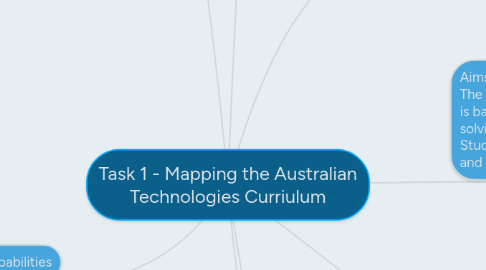
1. Content Structure
1.1. Strands Content is organised into two strands within each technology subject.
1.1.1. Knowledge and Understanding
1.1.2. Processes and Production Skills
1.2. Key Concepts Both subjects are based on the following ideas:
1.2.1. Overarching Idea: Creating preferred futures. This is about solving modern problems to work towards a sustainable future.
1.2.2. Project management. Students learn skills in organising, planning, and monitoring.
1.2.3. Thinking in technologies. Systems thinking, design thinking, and computational thinking.
1.3. Band Levels
1.3.1. Explanations of how learning contexts apply to the content descriptors.
1.3.2. Gives insight into how the two strands of learning in each subject are interrelated and can often be taught simultaneously at each Year Level.
1.4. Content Descriptors
1.4.1. Descriptions under each strand, each with an individual code, of the content and skills students should achieve within each subject,
1.5. Achievement Standards
1.5.1. Include examples of work and descriptions of work to demonstrate to teachers the levels that students should be achieving at in each Year Level and subject.
1.6. Content Elaborations
1.6.1. Elaborations give details about each content descriptor. Often they include suggestions of activities or more in- depth studies of the content descriptor.
2. General Capabilities
2.1. Literacy This subject encourages students to communicate their ideas in a variety of means and contexts, create written instruction, use language effectively and flexibly, and interpret information from a variety of sources.
2.2. Numeracy Technologies gives students the opportunity to apply mathematical knowledge and skills to real life situations.
2.3. Information and Communication Technology
2.3.1. Design and Technologies Students use ICT equipment to follow the process of design and to aid them in their work. In this way, ICT skills are strengthened.
2.3.2. Digital Technologies Students learning about the internal workings of actual ICT equipment, and how to maximise its effectiveness.
2.4. Critical and Creative Thinking Creativity and originality is to be encouraged in Technologies during all design and evaluating processes.
2.5. Personal and Social Capability As students engage in management processes, their personal and social skills are strengthened. During planning and critique stages, students are likely to participate in group work.
2.6. Ethical Understanding Students learn about safety in working with people, animals, data and online technology. They are encouraged to question existing and future technology and its benefits consequences for differing groups of people.
2.7. Intercultural Understanding Students consider how different areas of technology impact different groups of people on a local, regional, national, and global scale. They investigate how technologies could serve as a solution to problems within cultures and between cultures.
3. https://dtm4260.edublogs.org/wp-admin/post.php?post=2034&action=edit
4. Aims and Objectives The Technologies Curriculum is based around the idea of solving modern problems. Students will learn how, and be encouraged to:
4.1. Formulate solutions by undergoing a step by step process.
4.2. Use creativity in their own development of technology over the course.
4.3. Consider ethical, sustainability, and other kinds of issues during their learning process.
4.4. Be critical of their own and others' work, and problems that need to be solved.
5. Subjects of the Australian Technologies Curriculum
5.1. Design and Technology
5.1.1. Knowledge and Understanding
5.1.1.1. The impact that technology has on society in multiple contexts. For example, modern technologies in building, computing, producing food, and manufacturing goods.
5.1.2. Processes and Production of Skills
5.1.2.1. Following a creation process (generating, producing, evaluating, collaborating and managing) to produce designed solutions.
5.2. Digital Technology
5.2.1. Knowledge and Understanding
5.2.1.1. Learning the components of digital systems, how they work, and their use, and the representation of data.
5.2.2. Processes and Production of Skills
5.2.2.1. Collecting, managing, and analysing data, and using this information to create digital solutions through a process of defining, designing, implementing, evaluating, collaborating and managing.
